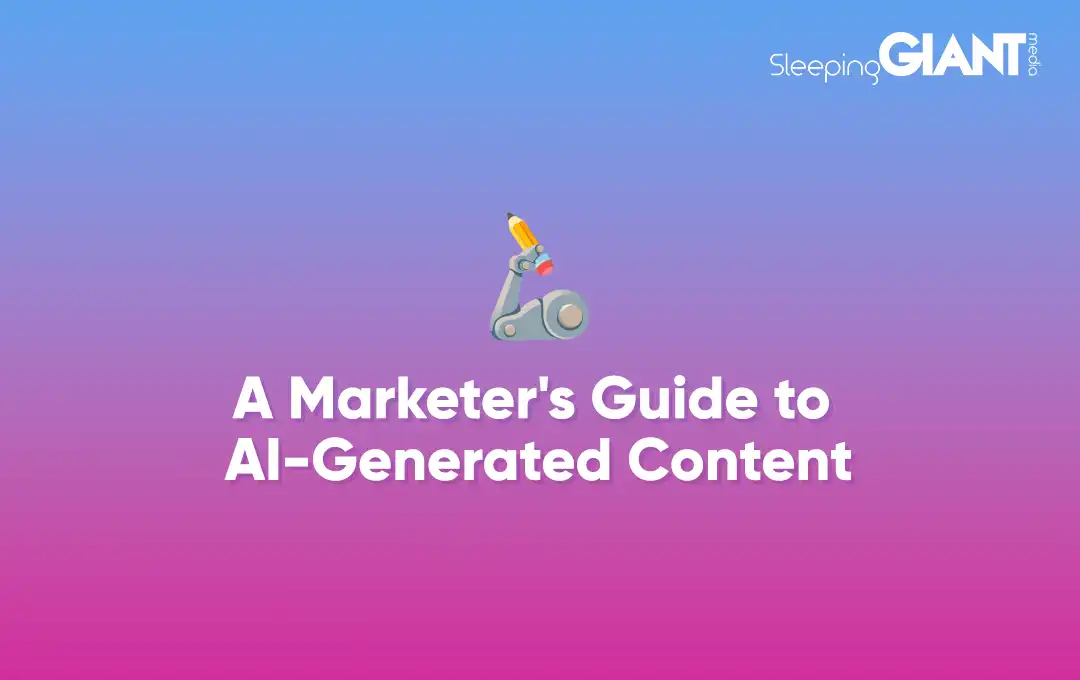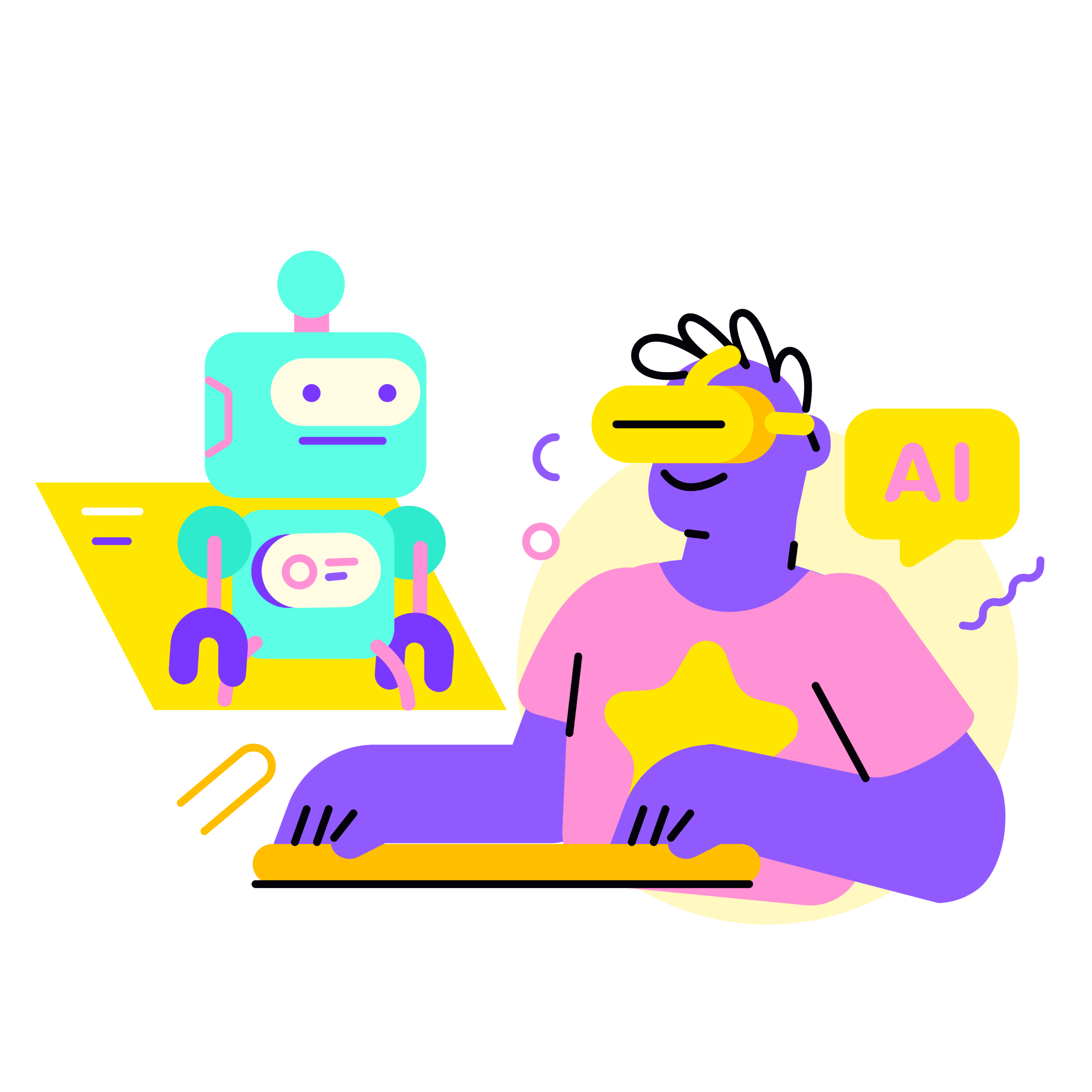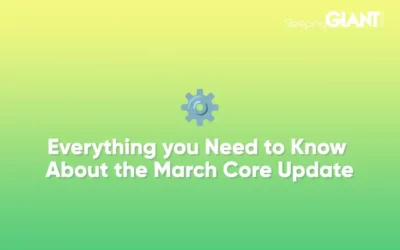
A Marketer’s Guide to AI-Generated Content
Did you know that 48% of marketers now use AI to assist them with content generation — and a further 10% plan on using it in the future?
Since generative AI tools such as ChatGPT made their debut a little over a year ago, they have well and truly changed the marketing game forever. A year on, we can safely say that we’re out of the ‘sensationalism’ phase where these new and exciting tools seemed like a fad. Now, as more and more individuals embrace this technology seriously, generative AI is gradually becoming a permanent feature in many marketers’ toolkits — and for good reason.
We’re entering the ‘refinement’ stage, where it’s up to individuals and businesses to leverage the potential of this technology and enhance our workflows and processes. In this blog, we’ll show you how.
Understanding AI-generated content
Before we outline the best practices for onboarding the newest extension of your marketing team, AI, let’s get to know it a little better. AI content is often seen in two minds — as unusable gibberish or the product of a highly complex process that isn’t accessible to individuals outside the tech world. Both of which are wrong!
What is AI-generated content?
AI-generated content refers to any text, images, videos, gifs, or other media types generated with the assistance of artificial intelligence technologies. In essence, any written or visual content that has not been directly produced by humans.
The spectrum of AI-generated content is broad, including everything from the creation of custom images to long-form blog content and short social media posts. A huge draw of AI-generated content is the time and effort it saves on behalf of the writer or designer. However, the task is now for marketers to learn how to meet the AI halfway — saving time where possible without compromising on quality or accuracy.
How does AI content generation work?
At its core, AI content generation is not a complex process; the algorithms and machine learning it relies upon, however, are.
AI content generation works by using computer programs that have learnt a lot of information from existing text to produce responses to prompts. These programs are called algorithms and they have a strong understanding of how language works by using machine learning and something known as NLP (or natural language processing). This allows them to mimic human linguistic structures in their responses while also analysing vast quantities of data and learning from context.
So, when you interact with a GPT, a ‘generative pre-trained transformer’, the AI is using what it knows to produce responses that look like they are written by a human.

What does Google think about AI-generated content?
Now that tools such as ChatGPT and Gemini have been around for a while now, they are, of course, being used in professional contexts like content writing and marketing. So much so, that Google themselves have produced some guidance on using AI-generated content.
Google’s quality guidelines
All content on the web is subject to a number of quality guidelines outlined by Google. This is to ensure that the content users are able to access is high-quality, valuable, helpful, accurate, and does not intentionally mislead or offer false information. Google is also keen to uphold integrity in its rankings, ensuring only the best content is served in those coveted high SERP positions.
So, what does Google have to say about AI content?
Their key message? “Rewarding high-quality content, however it is produced.” Now, don’t get ahead of yourselves; this doesn’t mean that Google happily turns a blind eye to blogs entirely written by ChatGPT. There are, as expected, caveats.
Google’s stance is that humans should be utilising AI insightfully to produce the kinds of content most valuable to users — these being ‘Helpful’ content and content that conforms to the ‘E-E-A-T’ acronym.
Helpful content
In line with Google’s Helpful Content update in August 2022, Google favours content that is purposefully designed to be helpful to users in their search for answers.
This should be content that demonstrates a depth of knowledge, contributes new or valuable information, and provides a satisfying reader experience for users.
E-E-A-T content
Google’s ranking systems always aim to reward original, high-quality content that demonstrates qualities of Expertise, Experience, Authoritativeness, and Trustworthiness. Now, at this point, if you’re thinking that AI tools can’t really demonstrate first-hand experience, you’d be correct. Human input is needed here as GPTs can only go so far.
Google stands firm on the fact that “using automation—including AI—to generate content with the primary purpose of manipulating ranking in search results” is a violation of their spam policies.
The latest
In March 2024, Google also rolled out their Spam and Core Updates — both of which contain new advice about AI-generated content with the aim of reducing the amount of spammy, low-quality content on the web.
It’s expected that the Core Update should reduce unhelpful content in Google Search by up to 40%. What’s more, one of the key areas of the Core Update, ‘Scaled content abuse’, strengthens Google’s spam policy on using automation (e.g. AI) to generate low-quality or unoriginal content at scale with the intention of manipulating rankings.
Leveraging AI-generated content for marketing
With that being said, and keeping Google’s guideline front of mind, let’s now take a look at how we can use AI-generated content in our marketing efforts.
From ideation and creation to optimisation and assistance in measuring performance, the uses of AI are endless. Below are just a few examples to get you thinking about the possible areas where you could harness the potential of AI-generated content.
- Idea generation. If you’re struggling to come up with ideas for your blogs, AI tools can be helpful in producing sample titles or concepts for you to use as launching-off points.
- Blog post creation. If you’re tasked with writing a long-form piece of content about a specialist topic you are not familiar with, you can always ask AI to produce a draft for you to read and get a feel for the style of content associated with said topic before writing yourself.
- Social media post content. By using specific prompts such as tone of voice and character limit, you can encourage an AI like ChatGPT to produce sample social media posts for you. Just remember, if these are about upcoming events or things in the news, the AI may ‘hallucinate’ certain information if it does not know for certain – so be careful.
- Email marketing copy. Generative AI can help you personalise your email marketing copy for different segments of your audience to help increase open rates and engagement.
- Transcripts for videos. There are AI tools out there that can watch videos and produce transcripts, saving you time. However, the accuracy of these transcriptions varies greatly as they will always need to be sense-checked by a human.

Caveats
With all of the examples listed above, however, it is essential to remember the core caveats that come with generative AI content. These include (but are not limited to):
- AI content should never be copied and pasted word-for-word as your own content.
- Generative AI tools often get things wrong and ‘hallucinate’ fake information, especially about current affairs and recent events. So, fact-check everything.
- Context matters. Sometimes, due to grammar and linguistic nuances, generative AI can produce text about something different than the prompt you entered, as it interprets the written cues wrong.
- Unless you enter specific prompts outlining a tone of voice and writing style, AI-generated content has a common, formulaic approach and style that can be picked up on by content writers and maybe even users. So, any content that it produces will need to be reworded by a human.
- If it’s SEO content you want, that definitely needs to come from a human. AI tools are getting better at naturally inserting keywords into text, but they struggle with context and cannot add embellishments such as vital internal links.
AI content Dos and Don’ts
To make things easier for marketers who are eager to integrate generative AI into their workflows — but not eager to anger the Google gods — here’s a list of the key dos and don’ts when it comes to generative AI.
Dos
✅ Review all content produced by generative AI to ensure that it is accurate, in line with your brand’s tone of voice, and, most importantly, adheres to Google’s quality guidelines.
✅ Allow AI to enhance your creativity — not hinder it. Let AI help you get those creative juices flowing and cure writer’s block with idea-generation sample drafts or blog outlines.
✅ Test AI at every given opportunity. You’ll only really know what generative AI can do for you by experimenting with it and seeing what it can do. Vary your prompts and search online for the success stories of others.
✅ Use detailed and informative prompts. Let’s say you had a PA; if you told them to bring you ‘a coffee’ but you wanted a caramel macchiato with oat milk and drizzle, that’s on you. So, tell your AI what you want.
Don’ts
❌ Never depend entirely on AI. Copying and pasting reams of ChatGPT-generated content is not only bad for content quality but also against Google’s guidelines which could land your site in some pretty hot water.
❌ Don’t neglect the human element. AI-generated content alone is never enough. Remember that you can’t have ‘Experience’ with human input.
❌ Don’t believe everything AI comes out with. While GPTs are increasingly trained on recent, accurate data, sometimes they just get it wrong. So, check dates, double-check sources, and triple-check any YMYL (your money or your life) content.
❌ Don’t forgo your brand styles. While generative AI opens up a world of possibilities when it comes to tone of voice and writing style, ultimately, AI should be tailored to you and your unique style.
You can’t beat human touch
If you’re looking for further guidance on using AI in your content marketing efforts, get in touch with our Giants — real-life humans! — and we can answer any questions that you may have.
In the meantime, be sure to keep the human-centred aspect of content creation front of mind. You can always rely on our expert team of content marketers to help strategise and optimise your content output.
In the meantime, keep up to date with our latest blogs for more digital marketing advice and insider tips.
Blog
Everything you Need to Know About the March Core Update
We knew it wouldn’t be long before Google released their first core update of...
Giant Wednesday
How To Optimise Images For Websites
Digital Marketing, technology & business insights, how-to's and explainer...




